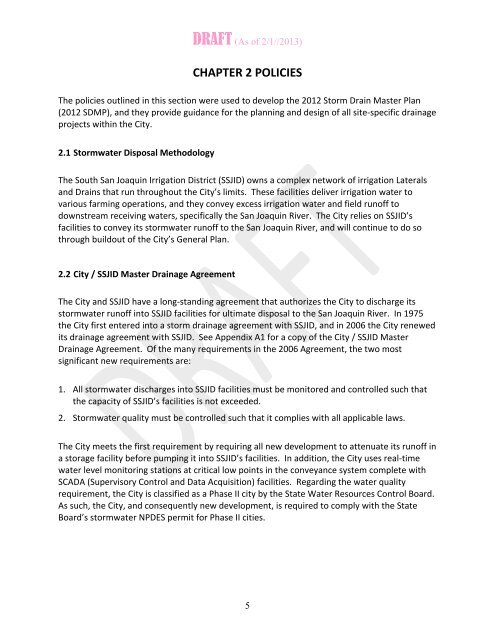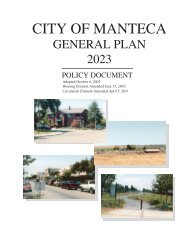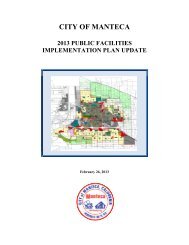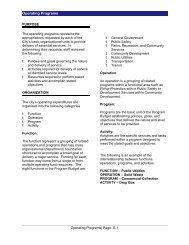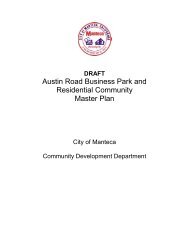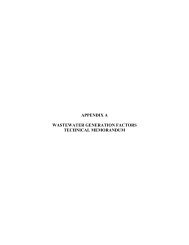R - City of Manteca
R - City of Manteca
R - City of Manteca
Create successful ePaper yourself
Turn your PDF publications into a flip-book with our unique Google optimized e-Paper software.
DRAFT (As <strong>of</strong> 2/1//2013)<br />
CHAPTER 2 POLICIES<br />
The policies outlined in this section were used to develop the 2012 Storm Drain Master Plan<br />
(2012 SDMP), and they provide guidance for the planning and design <strong>of</strong> all site‐specific drainage<br />
projects within the <strong>City</strong>.<br />
2.1 Stormwater Disposal Methodology<br />
The South San Joaquin Irrigation District (SSJID) owns a complex network <strong>of</strong> irrigation Laterals<br />
and Drains that run throughout the <strong>City</strong>’s limits. These facilities deliver irrigation water to<br />
various farming operations, and they convey excess irrigation water and field run<strong>of</strong>f to<br />
downstream receiving waters, specifically the San Joaquin River. The <strong>City</strong> relies on SSJID’s<br />
facilities to convey its stormwater run<strong>of</strong>f to the San Joaquin River, and will continue to do so<br />
through buildout <strong>of</strong> the <strong>City</strong>’s General Plan.<br />
2.2 <strong>City</strong> / SSJID Master Drainage Agreement<br />
The <strong>City</strong> and SSJID have a long‐standing agreement that authorizes the <strong>City</strong> to discharge its<br />
stormwater run<strong>of</strong>f into SSJID facilities for ultimate disposal to the San Joaquin River. In 1975<br />
the <strong>City</strong> first entered into a storm drainage agreement with SSJID, and in 2006 the <strong>City</strong> renewed<br />
its drainage agreement with SSJID. See Appendix A1 for a copy <strong>of</strong> the <strong>City</strong> / SSJID Master<br />
Drainage Agreement. Of the many requirements in the 2006 Agreement, the two most<br />
significant new requirements are:<br />
1. All stormwater discharges into SSJID facilities must be monitored and controlled such that<br />
the capacity <strong>of</strong> SSJID’s facilities is not exceeded.<br />
2. Stormwater quality must be controlled such that it complies with all applicable laws.<br />
The <strong>City</strong> meets the first requirement by requiring all new development to attenuate its run<strong>of</strong>f in<br />
a storage facility before pumping it into SSJID’s facilities. In addition, the <strong>City</strong> uses real‐time<br />
water level monitoring stations at critical low points in the conveyance system complete with<br />
SCADA (Supervisory Control and Data Acquisition) facilities. Regarding the water quality<br />
requirement, the <strong>City</strong> is classified as a Phase II city by the State Water Resources Control Board.<br />
As such, the <strong>City</strong>, and consequently new development, is required to comply with the State<br />
Board’s stormwater NPDES permit for Phase II cities.<br />
5


